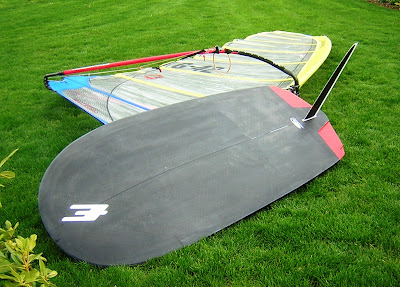 Check out these two pictures (courtesy Emmett MacDonald) - same sail, same amount of downhaul, taken within 3 minutes of each other at the Friday Night race in San Francisco in April.
Check out these two pictures (courtesy Emmett MacDonald) - same sail, same amount of downhaul, taken within 3 minutes of each other at the Friday Night race in San Francisco in April.
The obvious difference is that one of them is upwind, with the outhaul fairly tight, and the other is downwind, with the outhaul cracked off a bit, going deep. These two pictures tell the story as to why today's formula sails are so insanely rangey - upwind, there's good drive, w/o the leach going all soft and soggy; downwind, if you get hit with a gust or the board hits a wave and decelerates a bit, there's enough twist to prevent you from being pitched over the handlebars when the leach catches.
Earlier generations of big race sails were huge advances for their time - but there was a lot less range, and twist was a lot less refined. When I started racing in 99, the big sails could be tuned with low downhaul tension, resulting in great performance upwind but a scary ride off the breeze. Or they could be tuned with enough downhaul tension for the leech not to catch off the breeze, which resulted in great speed all around but horrible angle upwind.
Mind you, that night I was on a 9.9 when, reasonably, a 9.0 would have been much faster and more appropriate for all racers on the course except Big Ben Bamer (who later also confessed to his 10 feeling a little big at times...). With all that range, I can realistically get a away with a two-sail formula quiver. My 10.8 is powerful enough for racing in what, for West Coast standards, is stupid light air, while my 9.9 is raceable even when it starts blowing like stink. Sure, there are tradeoffs (I didn't much care for the lower upwind angle the bigger sail forces on you in survival conditions at this particular Friday night race, or in the last two heats of last year's Nationals) - but unless you race in the Bay Area a lot, it's hard to justify a 9.0 anymore, and unless you race in Florida or Europe, the same holds true for a 12. Guess it's time to buy Bruce a beer this weekend when I go down for the Gorge Cup.




